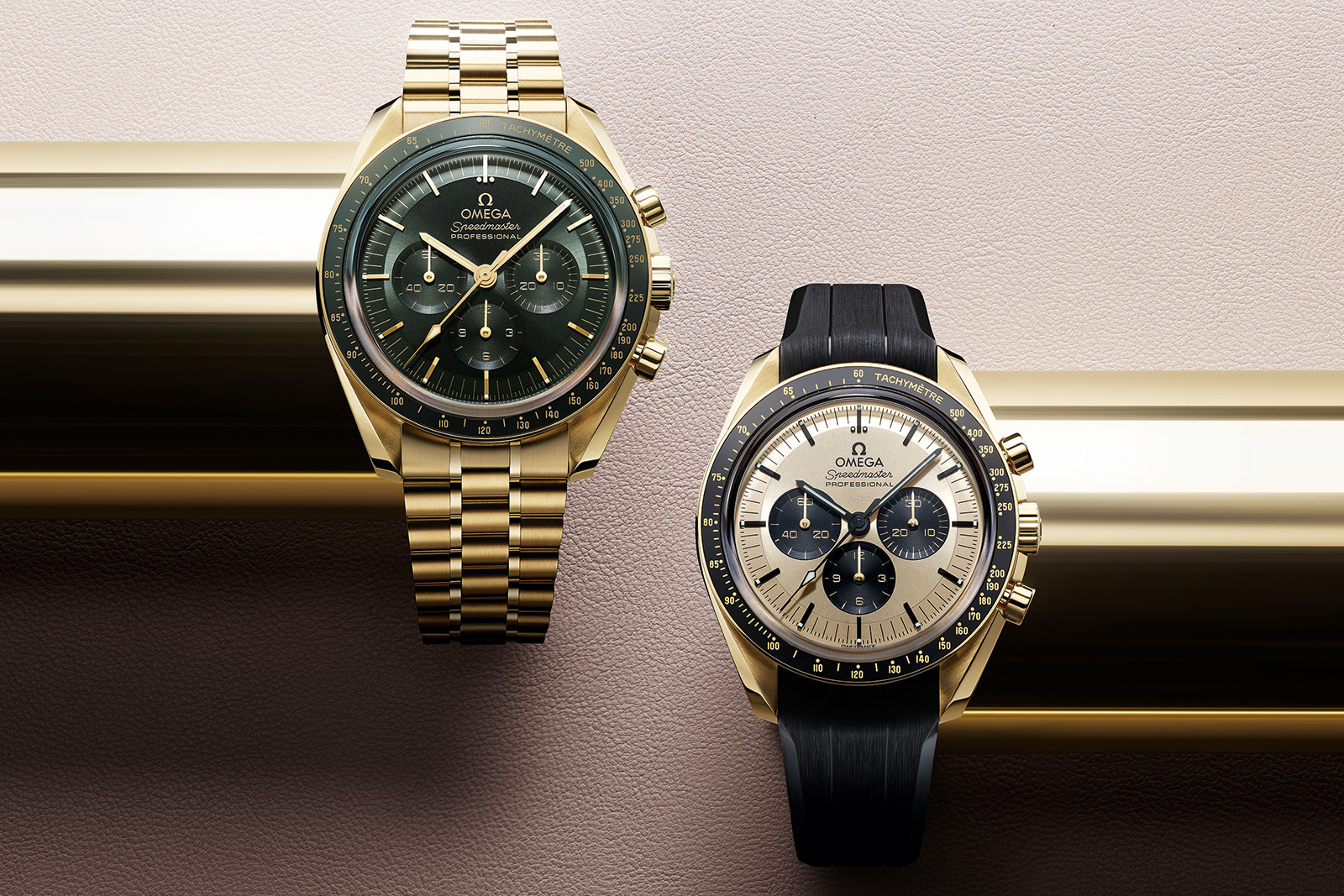Omega Introduces the Speedmaster Moonwatch in Moonshine Gold
An attractive pair in today's colours.
In 2021, Omega revamped its ubiquitous Moonwatch, giving it a thorough makeover that included an upgraded movement in the form of the Master Co-Axial cal. 3861. This year, Omega follows up with the Speedmaster Moonwatch 42 mm Moonshine Gold.
Omega’s proprietary pale-yellow gold alloy, Moonshine Gold was developed to celebrate the 50th anniversary of Moon landing, so it comes as no surprise that the alloy has made its way into the latest-generation Speedmaster with the cal. 3861.
The “panda” dial in solid Moonshine Gold with black registers
Initial thoughts
The Speedmaster Moonshine Gold Speedmasters are possibly the most striking version of the latest Moonwatch (though the Canopus Gold is a close second). Both iterations of the Speedmaster Moonshine Gold are in popular colours; green is currently hot and while Omega may not score points in originality, the brand is delivering what the market wants at the moment.
That said, the execution of the new Speedmasters is done well. The restrained use of modern material such as ceramic for the bezel insert gives the watch a polished yet traditional look, allowing it to retain the essence of its bestselling model. Put simply, it still looks like a Speedmaster Moonwatch, which is what matters.
And the unique, pale yellow tone of Moonshine Gold gives the new Speedmaster a slightly vintage look, albeit one with elements that are clearly modern. At the same time, the colour of the metal allows for a subtlety in appearance in spite of the large amount of gold, especially in the bracelet model.
Starting at US$24,600 on a leather strap and rising to US$36,500 on a gold bracelet, the Speedster isn’t quite a value proposition but priced fairly relative to other Speedmasters. The prices are on par with the Sedna Gold version and slightly less than the Canopus Gold variant.
Strong execution
Interestingly, Moonshine Gold has been rarely used as a case material on the Speedmaster Moonwatch despite its name. Debuted in 2019 on the Speedmaster Apollo 11 50th Anniversary, the alloy is a slightly paler in colour compared to conventional 18k yellow gold, in part due to its 14.5% silver content.
For the ones who prefer uniformity in colour and material, the “panda” dial would be the variant of choice. The dial is a solid disc of Moonshine Gold and matched with black hands and indices, which have just enough contrast. The combination is not too jarring, as it might be with a traditional black-on-white “panda” dial.
And for someone who wants something more trendy, there’s the all-green model that has a green bezel and dial. Though the colour is new, the unbroken colour from bezel and dial means it resembles the traditional Moonwatch.
The traditional thin sets the Speedmaster apart from most modern chronographs that have bold, wide bezels
An interesting detail is the rubber strap with a fine, linear pattern on top and a lunar surface pattern in relief on the underside
The watches are powered by the cal. 3861 that was introduced in 2019. Essentially an upgraded version of the Lemania cal. 1861 (or 1863) that was found in the Moonwatch since the late 1960s, the cal. 3861 boasts several technical improvements.
Amongst them is a Co-Axial escapement made of anti-magnetic alloys, giving it high levels of magnetism resistance. Like all high-end Omega calibres, the cal. 3861 is certified by the federal Swiss measurements authority METAS, making the Speedmaster a Master Chronometer.
One notable omission, at least in terms of aesthetics, is the rhodium finish on the movement. Unlike other the limited edition Speedmaster Apollo XI in Moonshine Gold, the new pair doesn’t have movements plated to match the case.
Key facts and price
Omega Speedmaster Moonwatch Professional Co-Axial Master Chronometer Chronograph 42 mm Moonshine Gold
Ref. 310.60.42.50.10.001 (green, bracelet)
Ref. 310.63.42.50.10.001 (green, strap)
Ref. 310.60.42.50.99.002 (gold, bracelet)
Ref. 310.62.42.50.99.001 (gold, strap)
Diameter: 42 mm
Height: 13.12 mm
Material: 18k Moonshine Gold
Crystal: Sapphire
Water resistance: 50 m
Movement: Cal. 3861
Features: Hours, minutes, seconds, and chronograph
Frequency: 25,200 beats per hour (3.5 Hz)
Winding: Hand-wound
Power reserve: 60 hours
Strap: Leather, rubber, or matching Moonshine Gold bracelet
Limited edition: No
Availability: At Omega boutiques and retailers
Price:
Green, strap – US$24,600
Green, bracelet – US$34,800
Gold, strap – US$26,400
Gold, bracelet – US$36,500
For more, visit Omegawatches.com.
Correction March 13, 2022: The case thickness is 13.18 mm, and not 18.12 mm as stated in an earlier version of the article.
Back to top.